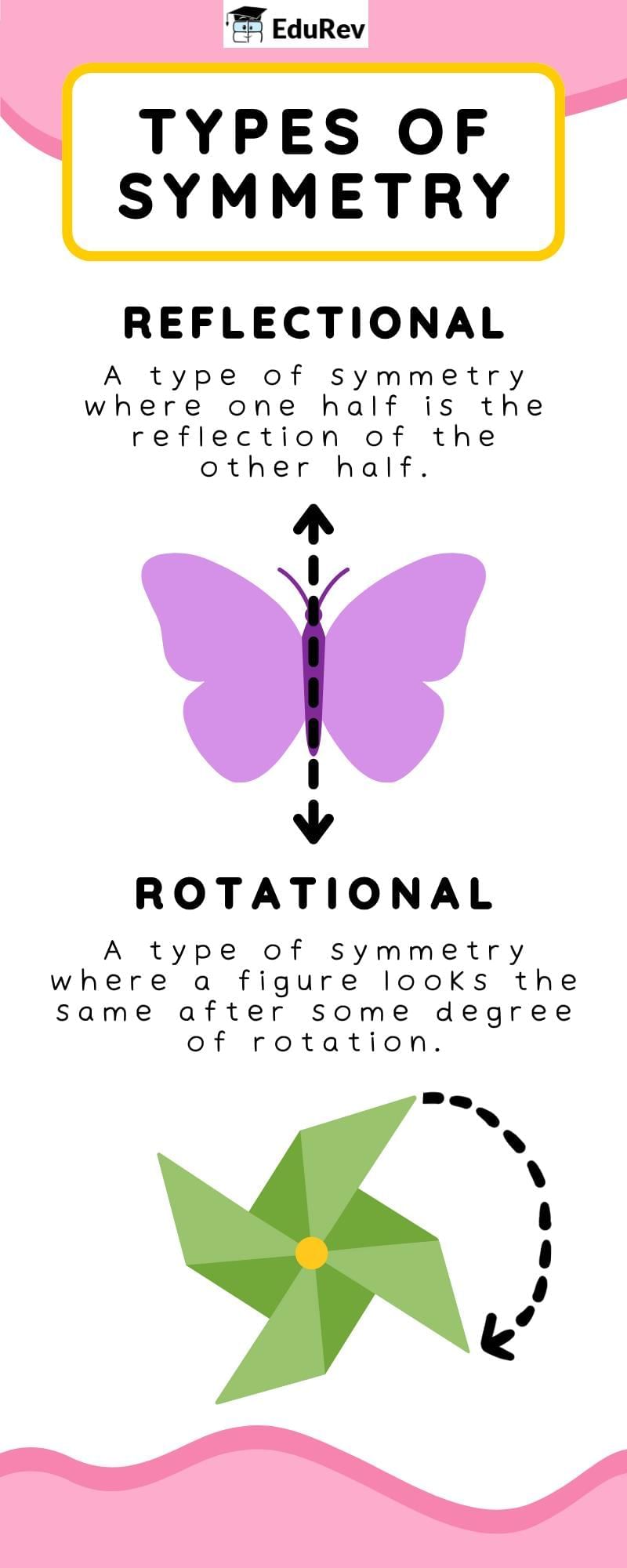Class 5 Exam > Class 5 Notes > Mathematics (Maths Mela) Class 5 - New NCERT > Let's Learn: Types of Symmetry
Let's Learn: Types of Symmetry | Mathematics (Maths Mela) Class 5 - New NCERT PDF Download

The document Let's Learn: Types of Symmetry | Mathematics (Maths Mela) Class 5 - New NCERT is a part of the Class 5 Course Mathematics (Maths Mela) Class 5 - New NCERT.
All you need of Class 5 at this link: Class 5
|
35 videos|276 docs|7 tests
|
FAQs on Let's Learn: Types of Symmetry - Mathematics (Maths Mela) Class 5 - New NCERT
| 1. What are the different types of symmetry? |  |
Ans. There are several types of symmetry, including:
1. <b>Reflective Symmetry (Mirror Symmetry)</b>: This occurs when one half of an object is a mirror image of the other half. An example is a butterfly.
2. <b>Rotational Symmetry</b>: This is when an object looks the same after a certain amount of rotation. For instance, a star shape can have rotational symmetry.
3. <b>Translational Symmetry</b>: This happens when an object can be moved (translated) along a certain direction and still look the same. A tiled floor is a good example.
4. <b>Radial Symmetry</b>: This type of symmetry is found in objects that can be divided into similar sections around a central point, like a wheel or a flower.
5. <b>Glide Reflection Symmetry</b>: This is a combination of reflection and translation, where an object is reflected over a line and then slid along that line.
| 2. How can we identify symmetry in everyday objects? |  |
Ans. To identify symmetry in everyday objects, you can look for specific characteristics:
- <b>Mirror Lines</b>: Check if you can draw a line through the object where both sides are identical. This indicates reflective symmetry.
- <b>Rotation</b>: Try to rotate the object around a point. If it looks the same after a certain angle, it has rotational symmetry.
- <b>Tiling Patterns</b>: Observe patterns on walls or floors. If the pattern can be repeated without any gaps or overlaps, it shows translational symmetry.
- <b>Shapes of Nature</b>: Many natural objects, such as leaves and flowers, exhibit radial symmetry. Look for how many identical parts surround a central point.
| 3. Why is symmetry important in art and design? |  |
Ans. Symmetry is important in art and design for several reasons:
1. <b>Aesthetic Appeal</b>: Symmetrical designs are often perceived as more beautiful and balanced, attracting viewers' attention.
2. <b>Organization</b>: Symmetry helps organize visual elements, making it easier for viewers to navigate and understand the artwork or design.
3. <b>Symbolism</b>: Many cultures associate symmetry with harmony and perfection, which can convey deeper meanings in artistic expressions.
4. <b>Functionality</b>: In design, symmetry can enhance the functionality of objects, like furniture or architecture, making them more stable and easier to use.
| 4. Can you give examples of symmetry in nature? |  |
Ans. Yes, symmetry is prevalent in nature. Some examples include:
- <b>Flowers</b>: Many flowers, such as daisies and tulips, exhibit radial symmetry with petals arranged around a central point.
- <b>Animals</b>: Creatures like starfish display radial symmetry, while most mammals, including humans, have bilateral symmetry.
- <b>Snowflakes</b>: Each snowflake has a unique pattern but generally exhibits six-fold rotational symmetry.
- <b>Leaves</b>: The arrangement of veins in leaves often shows reflective symmetry, with one side mirroring the other.
| 5. How does symmetry relate to mathematics? |  |
Ans. Symmetry is deeply connected to mathematics in various ways:
1. <b>Geometric Shapes</b>: Many geometric shapes, like squares and circles, have defined lines of symmetry that can be analyzed mathematically.
2. <b>Patterns and Transformations</b>: The study of symmetry involves understanding transformations such as rotation, reflection, and translation, which are fundamental concepts in geometry.
3. <b>Algebraic Symmetry</b>: In algebra, symmetry can help solve equations and understand functions through symmetry properties.
4. <b>Fractals</b>: Certain mathematical sets, like fractals, exhibit self-similarity, a form of symmetry that repeats at different scales.
Related Searches




















